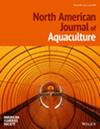Digestibility of corn distiller's dried grains with solubles in practical feeds with phytase and xylanase treatment fed to Nile tilapia
IF 1.3
4区 农林科学
Q3 FISHERIES
引用次数: 0
Abstract
Abstract Distiller's dried grains with solubles (DDGS), a byproduct of ethanol production from cereal grains, has seen limited use by fish feed manufacturers as an alternative protein source. Over the past 20 years, advances and greater uniformity in processing methods have improved the quality of DDGS, and likely, its digestibility by fish. Our objective was to reevaluate the digestibility of corn DDGS by Nile tilapia using a present‐day commercial product. Apparent digestibility coefficients (ADC) for the major proximate nutrients (dry matter, crude protein, crude fat, ash, digestible energy, and phosphorus) were determined using a practical, commercial‐type feed that was formulated and processed with DDGS supplied at 30% as w:w substitution (DDGS diet) of the reference diet (Ref). After drying, Ref and DDGS diets were top‐coated with phytase (3310 FTU/kg) + xylanase (7665 BXU/kg) enzymes (Ref+ and DDGS+) and compared to their untreated dietary counterparts. Digestibility of crude protein was similar among diets and unaffected by enzyme treatment. For dry matter and digestible energy, ADC values were significantly lower for the DDGS diet, but enzyme addition improved digestibility to that of the Ref diets. Apparent digestibility for crude fat and ash was significantly better for the DDGS feed with ash digestibility improved after treatment with xylanase + phytase for both Ref+ and DDGS+. For phosphorus, digestibility was similar among the Ref, Ref+, and DDGS diets, but with enzyme treatment, the phosphorus ADC increased significantly in DDGS+. Results of this digestibility trial show that corn DDGS is a highly digestible protein source for use in feeds of Nile tilapia at 30% of diet. Generally, apparent digestibility of proximate nutrients was either better or similar in DDGS when compared to the reference diet and could be further improved with addition of xylanase + phytase.经植酸酶和木聚糖酶处理的玉米酒糟干颗粒对尼罗罗非鱼的消化率
摘要酒糟干颗粒可溶物(DDGS)是谷物乙醇生产的副产品,作为替代蛋白质来源,鱼饲料制造商的使用有限。在过去的20年里,加工方法的进步和更大的一致性提高了DDGS的质量,也可能提高了它的鱼消化率。我们的目的是重新评估尼罗罗非鱼对玉米DDGS的消化率。主要近似营养物质(干物质、粗蛋白质、粗脂肪、灰分、可消化能和磷)的表观消化率系数(ADC)是用一种实用的、商业化的饲料来确定的,这种饲料是用DDGS配制和加工的,DDGS以30%的w:w替代参考饲料(Ref)。干燥后,在Ref和DDGS日粮上包被植酸酶(3310 FTU/kg) +木聚糖酶(7665 BXU/kg)酶(Ref+和DDGS+),并与未处理的日粮进行比较。不同饲粮的粗蛋白质消化率相似,且不受酶处理的影响。对于干物质和消化能,DDGS日粮的ADC值显著降低,但酶的添加使消化率高于Ref日粮。DDGS饲料对粗脂肪和粗灰分的表观消化率显著提高,且木聚糖酶+植酸酶处理均提高了粗灰分消化率。对于磷,Ref、Ref+和DDGS日粮的消化率相似,但在酶处理下,DDGS+日粮的磷ADC显著增加。消化率试验结果表明,玉米DDGS是尼罗罗非鱼饲料中30%的高消化蛋白源。总体而言,DDGS对近端营养物质的表观消化率优于或与对照饲料相近,添加木聚糖酶+植酸酶可进一步提高其表观消化率。
本文章由计算机程序翻译,如有差异,请以英文原文为准。
求助全文
约1分钟内获得全文
求助全文
来源期刊
CiteScore
2.50
自引率
0.00%
发文量
46
审稿时长
18-36 weeks
期刊介绍:
The North American Journal of Aquaculture publishes papers on new research and practical experience in all areas of intensive and extensive fish culture. Topics include broodstock selection and spawning, nutrition and feeding, health and water quality, facilities and production technology, and the management of ponds, pens, and raceways.
The journal will consider papers dealing with ways to improve the husbandry of any aquatic species—marine or freshwater, vertebrate or invertebrate—raised for commercial, scientific, recreational, enhancement, or restoration purposes that may be of interest to practitioners in North America. Its scope includes both basic and applied science, but applied scientific endeavors—including practical experiences, descriptive studies, and other nontraditional, but pertinent works—are emphasized.

 求助内容:
求助内容: 应助结果提醒方式:
应助结果提醒方式:


